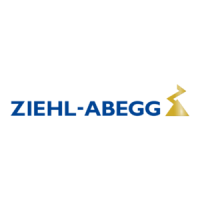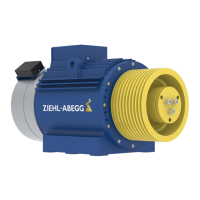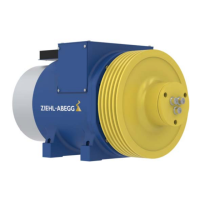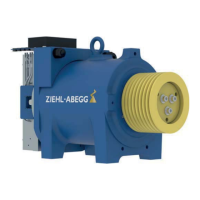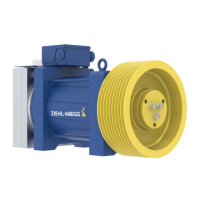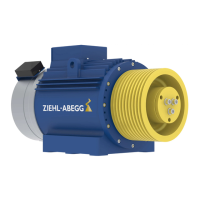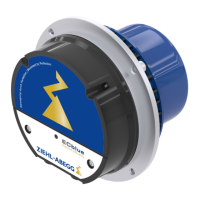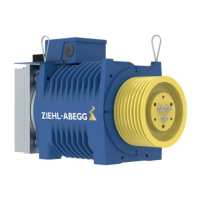
Do you have a question about the ZIEHL-ABEGG ZA top SM200.40E and is the answer not in the manual?
| Motor technology | ECblue |
|---|---|
| Frequency | 50/60 Hz |
| Motor speed | 2000 rpm |
| Thermal class | F |
| Protection class | IP54 |
| Speed | 2000 rpm |
Explains the purpose and use of these instructions for safe operation.
Identifies intended users and required qualifications for operating the machine.
Outlines manufacturer's liability limitations regarding misuse or unauthorized modifications.
States copyright protection and usage restrictions for the document content.
Provides overall safety context, general rules, and references to standards.
Defines the product's proper application and limitations to prevent misuse.
Explains safety symbols and their corresponding hazard levels.
Details product reliability and conditions for safe installation and operation.
Specifies required skills, knowledge, and responsibilities for personnel.
Covers specific hazards like electrical, lifting, hot surfaces, and operational limits.
Outlines operator responsibilities for ensuring safe machine operation and maintenance.
Provides safety guidance and information requirements for external workers.
Describes the intended applications and environments for the elevator machine.
Explains the information and technical data found on the product's rating plate.
Details safe procedures for shipping, handling, and packaging the elevator machine.
Provides instructions for storing the elevator machine correctly to prevent damage.
Outlines environmentally sound disposal methods for the elevator machine.
Offers general recommendations and precautions for machine mounting.
Details the procedure for securing the elevator machine using specified hardware.
Explains the correct method for attaching the lift ropes to the traction sheave.
Describes methods and considerations for pulling lift ropes during installation.
Covers the mounting and adjustment of the rope guard for safety.
Specific instructions for rope guard attachment with 160-240mm sheave diameter.
Specific instructions for rope guard attachment with 320mm sheave diameter.
Specific instructions for rope guard attachment with 400-500mm sheave diameter.
Discusses relevant patent considerations and installation suggestions.
Highlights critical safety measures for electrical work and component handling.
Addresses electromagnetic compatibility requirements for the system.
Covers technical specifications and connection details for the motor.
Specifies requirements for motor cable sizing based on current and conditions.
Recommends using shielded cables for motor connection.
Details limitations and implications of motor cable length on EMC performance.
Covers connection requirements, thread sizes, and tightening torques.
Explains correct wiring phase sequence and inverter configuration.
Details the procedure for proper grounding, including cross-section requirements.
Describes how to connect and evaluate temperature sensors (PTC/PT100).
Specifies maximum permissible encoder cable length and available options.
Provides pinout details for various absolute encoder models and connections.
Explains how to set the absolute encoder offset and recalibration requirements.
Defines the intended use and limitations of the brake system.
Describes how to manually release the brake using available systems.
Explains the function and importance of brake release monitoring for safety.
Details methods for activating and controlling the brake via contactors or other systems.
Covers brake wiring, connection safety, and protective measures.
Illustrates various brake wiring configurations, including microswitch and proximity switch.
Provides specifications for the optional forced ventilation unit.
Shows how to wire the forced ventilation system.
Specifies requirements for the environment and installation before commissioning.
Lists essential checks and preparations before the initial power-on.
Describes essential tests for system validation and safety checks.
Explains procedures for engaging and disengaging the safety gear.
Details steps for safe emergency evacuation of the elevator car.
Diagnoses and addresses unusual sounds originating from the elevator machine.
Covers faults related to excessive heat and activation of temperature protection.
Diagnoses common reasons for the elevator machine failing to start.
Identifies and resolves issues preventing the brake from releasing correctly.
Addresses noise problems that may occur during brake operation.
Troubleshoots problems related to the brake release monitoring system.
Provides overall principles and safety guidelines for machine upkeep.
Lists required inspections, intervals, and items to check.
Lists components available for replacement and their corresponding part numbers.
Provides comprehensive technical data for various machine components.
Presents mechanical dimensions, layouts, and key features of the machine.
Declares compliance of the elevator machine with relevant EU directives.
Provides specific instructions for the brake system's operation and installation.
Declares conformity of the brake component with relevant EU directives.
Certifies compliance of the safety component with elevator directives.
Presents calculations for elevator tripping speeds based on various parameters.
Provides evidence and confirmation for traction sheave shaft calculations.
Provides technical data for the motor, including torque, speed, and load capacity.
Lists dimensions for various traction sheave diameters and widths.
Specifies IP protection ratings for motor, brake, encoder, and ventilation.
Details requirements for ambient temperature, humidity, and installation height.
Provides technical data for the brake, including torque, voltage, and protection.
Technical data and characteristics for the microswitch used in release monitoring.
Technical data and characteristics for the proximity switch used in release monitoring.
Summarizes findings from type examinations regarding brake torques and switching times.
Step-by-step guide for assembling and adjusting the microswitch release monitor.
Step-by-step guide for assembling and adjusting the proximity switch release monitor.
